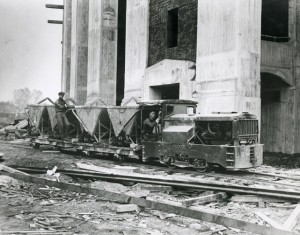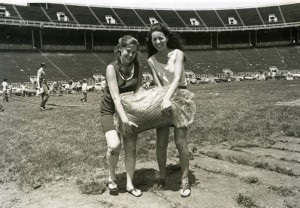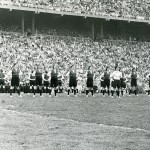It may have seemed to initial supporters that they had to move mountains to pay for the construction of the Ohio Stadium, but engineers actually did have to move a river since it was built on a floodplain. Some lesser-known facts about the campus’ best-known building:
OSU Trustees wanted the Stadium to be paid for with private money so the University’s requests for financial support from the state legislature would not be compromised. So, in 1919, a campus whose entire value in land and buildings was $7 million, began – through its alumni – to raise $1 million for an addition. This would be tantamount to today’s University adding, in one year, $150 million to its $1 billion-plus endowment fund, or 250 acres to its 1,700-acre Columbus campus.
Howard Dwight Smith, a civil engineer and Ohio State alum known for designing Long Island and Fifth Avenue mansions, was tapped to design the new Stadium. He drew a U-form design, combining attributes of the two largest football stadiums of the day: those of Harvard and Yale. It was the first horseshoe-shaped, double-deck stadium in the United States. The proposed structure, which was to hold 63,000 fans, would require 40,000 cubic yards of concrete and 4,000 tons of steel. A short-line railroad was built solely to support stadium construction, eventually transporting 60,000 tons of gravel, 30,000 tons of sand, and 1.8 million feet of lumber.
An infamous Michigan game in 1926 led to the first of many modifications. In front of a standing-room-only crowd, leading 10-0 after one quarter, the Buckeyes failed to stop Michigan’s passing game, looking, as the Makio later said, “almost as helpless as London during a German Zeppelin raid.” Michigan led 17-10 with two minutes to play when Ohio State scored on a 12-yard run – and missed the extra point. Michigan ran out the clock, and 90,000 Ohio State fans rioted, storming the field, throwing glass bottles, breaking arms and legs. The University thereafter banned standing-room-only; the policy remained in place nearly 50 years.
On June 14, 1971, Woody Hayes greeted souvenir-seekers at the Stadium, while behind him its natural sod was cut into 12,000 individual rolls. In exchange for a donation to the a new artificial turf fund, about 5,000 fans left with a piece of bona fide stadium grass, lugging it home in their arms or sliding it into the backs of station wagons, to be sown into lawns across the country. From March to May 1989, grass was reinstalled in Ohio Stadium. A 2001 renovation resulted in the Stadium’s sod being better shielded from the elements, so FieldTurf, a second-generation artificial grass, softened by an embedded layer of black rubber pellets and sand, was installed in 2007; the natural turf was given to the City of Columbus, to be installed across three baseball fields.
 The Stadium has had other uses over the years, including a subsidized dorm for needy students, class laboratories, and the Stadium Theater, which began beneath the east stands in the summer of 1950. Bleachers in the breezeway at Gate 10 held as many as 300 people. During the program’s eight-week season, students and interested members of the community collaborated to run six Broadway plays, four nights each. That July 5, Stadium Theater’s first audience was treated to “The Male Animal,” whose script by OSU alum James Thurber refers to the popular soda fountain Hennick’s, the Neil Avenue gate, and a rivalry with Michigan. The program moved into Hughes Hall in 1968, and into Mershon Auditorium in 1970.
The Stadium has had other uses over the years, including a subsidized dorm for needy students, class laboratories, and the Stadium Theater, which began beneath the east stands in the summer of 1950. Bleachers in the breezeway at Gate 10 held as many as 300 people. During the program’s eight-week season, students and interested members of the community collaborated to run six Broadway plays, four nights each. That July 5, Stadium Theater’s first audience was treated to “The Male Animal,” whose script by OSU alum James Thurber refers to the popular soda fountain Hennick’s, the Neil Avenue gate, and a rivalry with Michigan. The program moved into Hughes Hall in 1968, and into Mershon Auditorium in 1970.
To build the Stadium, a bend in the Olentangy River bed was straightened, and natural drainage ditches and gullies were routed into trunk sewers. The land east of the river was graded and paved. The river has, from time to time, reclaimed what the Stadium occupied. During spring break 1927, the Olentangy broke its banks, flooding the south towers and the track, but sparing the football field.
Floods across Ohio in 1937, which devastated Cincinnati, brought what the Alumni Monthly called a “rampaging Olentangy” to the polo fields south of the Stadium. The Stadium itself was largely spared. While the city of Columbus suffered through the statewide flood of January 1959, the frozen fields south of the stadium flooded, again sparing the building itself. A flood in June 1973 similarly covered the polo fields in three feet of water, but left the Stadium dry. In a May 1947 track meet at the Stadium, Ohio State’s men’s track team stunned Indiana and, in the words of the Alumni Monthly, impressed its own swimming coach. Flash flooding had left inches of stagnant water on the track, forcing runners to continue ankle-deep, but hardly stopping OSU’s Ed Porter and Harry Cogswell from placing first and second in the 440.
To learn other interesting facts about the Stadium, visit our web exhibit, “Walk in Our Shoe,” (http://library.osu.edu/projects/stadium/)











Recent Comments